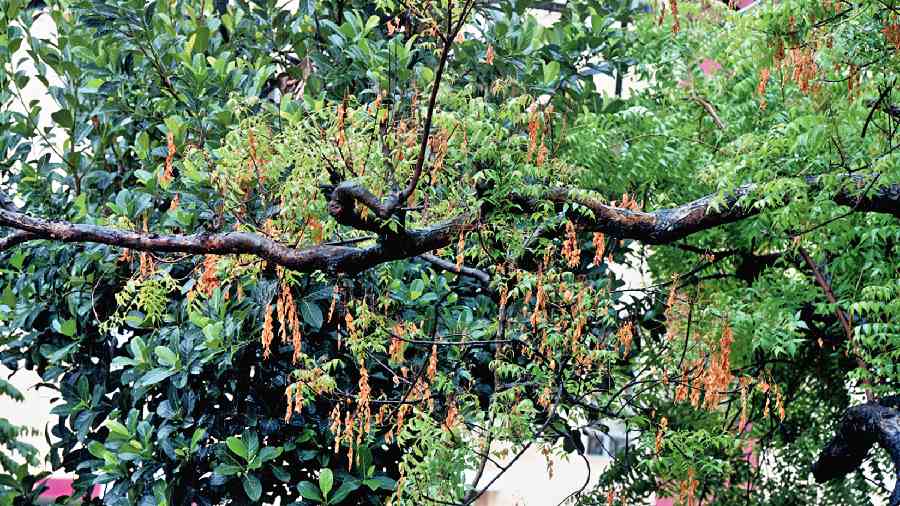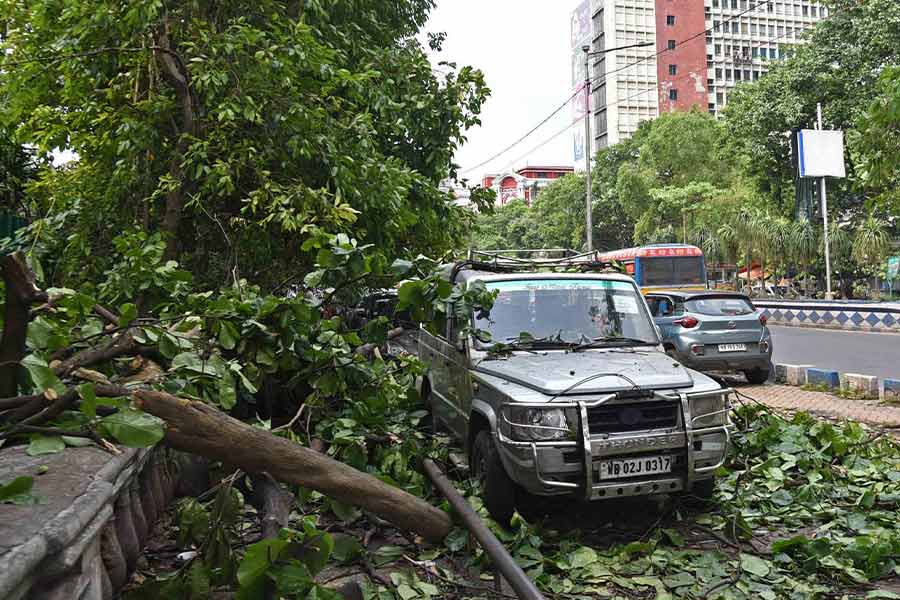Neem trees across Kolkata are being affected by an unknown disease, the state’s biodiversity board has said.
The trees may start dying soon, repeating what had happened with sirish trees a few years ago unless remedial steps are taken immediately.
“For last couple of weeks, we have been observing that newly grown twigs and leaves of neem trees are drying and drooping and turning brown. This is happening across Kolkata and Salt Lake,” said H.S. Debnath, the chairman of the board.
“Many affected trees can be found in the Salt Lake, New Town areas, along Sarat Bose Road, Elgin Road, Golpark, Southern Avenue and the Rashbehari Avenue connector,” said a board official.
“It is reminding us about a similar infection within sirish trees. We need quick action.”
Hundreds of sirish trees in the city have died over the past five years after being affected by a disease that could not be cured.
“We, however, have started to treat an old affected neem tree near the Sarat Bose Road and Elgin Road crossing. The initial feedback is encouraging,” said Anupama Mitra, a horticulturist associated with the board.
According to Mitra, the exact cause has not been ascertained yet but “it is unlikely to be insect triggered”.
It could be fungal or viral infection.
Debnath said weather might have played a part too.
Experts The Telegraph has spoken to said a similar infection, called dieback disease, affected neem trees earlier in Coimbatore, Pune, Nagpur and Telangana. It was caused by a fungus called Phomopsis azadirachtae.
A senior official of Kolkata Municipal Corporation’s parks and gardens department said the city has at least 2,000 neem trees. “We have planted many neem trees recently,” he said.
Neem is considered extremely useful in urban forestry because of its great ability to withstand air and water pollution as well as heat.
According to experts, the species also helps in maintaining soil fertility.
“More than 60 patents have been claimed on various products of neem. It is also important commercially,” said a board official.
Neem trees across Kolkata are being affected by an unknown disease, the state’s biodiversity board has said.
The trees may start dying soon, repeating what had happened with sirish trees a few years ago unless remedial steps are taken immediately.
“For last couple of weeks, we have been observing that newly grown twigs and leaves of neem trees are drying and drooping and turning brown. This is happening across Kolkata and Salt Lake,” said H.S. Debnath, the chairman of the board.
“Many affected trees can be found in the Salt Lake, New Town areas, along Sarat Bose Road, Elgin Road, Golpark, Southern Avenue and the Rashbehari Avenue connector,” said a board official.
“It is reminding us about a similar infection within sirish trees. We need quick action.”
Hundreds of sirish trees in the city have died over the past five years after being affected by a disease that could not be cured.
“We, however, have started to treat an old affected neem tree near the Sarat Bose Road and Elgin Road crossing. The initial feedback is encouraging,” said Anupama Mitra, a horticulturist associated with the board.
According to Mitra, the exact cause has not been ascertained yet but “it is unlikely to be insect triggered”.
It could be fungal or viral infection.
Debnath said weather might have played a part too.
Experts The Telegraph has spoken to said a similar infection, called dieback disease, affected neem trees earlier in Coimbatore, Pune, Nagpur and Telangana. It was caused by a fungus called Phomopsis azadirachtae.
A senior official of the Kolkata Municipal Corporation’s parks and gardens department said the city has at least 2,000 neem trees. “We have planted many neem trees recently,” he said.
Neem is considered extremely useful in urban forestry because of its great ability to withstand air and water pollution as well as heat.
According to experts, the species also helps in maintaining soil fertility.
“More than 60 patents have been claimed on various products of neem. It is also important commercially,” said a board official.






